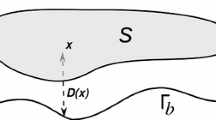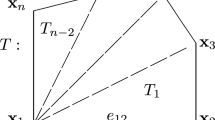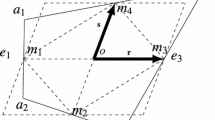Abstract
In this study, we investigate how low the degree of polynomials can be to construct a stable conservative pair for incompressible Stokes problems that works on general triangulations. We propose a finite element pair that uses a slightly enriched piecewise linear polynomial space for velocity and piecewise constant space for pressure. The pair is illustrated to be a lowest-degree stable conservative pair for Stokes problems on general triangulations.













Similar content being viewed by others
Data Availability
Enquiries about data availability should be directed to the authors.
References
Arnold, D.N.: Finite Element Exterior Calculus. SIAM (2018)
Arnold, D.N., Falk, R., Winther, R.: Finite element exterior calculus, homological techniques, and applications. Acta Numer. 15, 1–155 (2006)
Arnold, D.N., Qin, J.: Quadratic velocity/linear pressure Stokes elements. In: Advances in Computer Methods for Partial Differential Equations VII, IMACS, 28–34 (1992)
Auricchio, F., Beirão da Veiga, L., Lovadina, C., Reali, A.: The importance of the exact satisfaction of the incompressibility constraint in nonlinear elasticity: mixed FEMs versus NURBS-based approximations. Comput. Methods Appl. Mech. Eng. 199, 314–323 (2010)
Auricchio, F., Beirão da Veiga, L., Lovadina, C., Reali, A., Taylor, R.L., Wriggers, P.: Approximation of incompressible large deformation elastic problems: some unresolved issues. Comput. Mech. 52, 1153–1167 (2013)
Boffi, D., Brezzi, F., Fortin, M.: Mixed Finite Element Methods and Applications. Springer, Berlin (2013)
Brezzi, F.: On the existence, uniqueness and approximation of saddle-point problems arising from Lagrangian multipliers. R.A.I.R.O. Anal. Numér. 2, 129–151 (1974)
Chen, S., Dong, L., Qiao, Z.: Uniformly convergent \(H(\text{ div})\)-conforming rectangular elements for Darcy-Stokes problem. Sci. China Math. 56, 2723–2736 (2013)
Cockburn, B., Nguyen, N.C., Peraire, J.: A comparison of HDG methods for stokes flow. J. Sci. Comput. 45, 215–237 (2010)
Cockburn, B., Gopalakrishnan, J.: The derivation of hybridizable discontinuous Galerkin methods for Stokes flow SIAM. J. Numer. Anal. 47, 1092–1125 (2009)
Falk, R.S., Morley, M.E.: Equivalence of finite element methods for problems in elasticity. SIAM J. Numer. Anal. 27, 1486–1505 (1990)
Falk, R.S., Neilan, M.: Stokes complexes and the construction of stable finite elements with pointwise mass conservation. SIAM J. Numer. Anal. 51, 1308–1326 (2013)
Gauger, N.R., Linke, A., Schroeder, P.W.: On high-order pressure-robust space discretisations, their advantages for incompressible high Reynolds number generalised Beltrami flows and beyond. SMAI J. Comput. Math. 5, 89–129 (2019)
Guzmán, J., Neilan, M.: A family of nonconforming elements for the Brinkman problem. IMA J. Numer. Anal. 32, 1484–1508 (2012)
Guzmán, J., Neilan, M.: Conforming and divergence-free stokes elements on general triangular meshes. Math. Comput. 83, 15–36 (2014)
Guzmán, J., Neilan, M.: Inf-sup stable finite elements on barycentric refinements producing divergence-free approximations in arbitrary dimensions. SIAM J. Numer. Anal. 56, 2826–2844 (2018)
Guzmán, J., Neilan, M.: Conforming and divergence-free stokes elements in three dimensions. IMA J. Numer. Anal. 34, 1489–1508 (2013)
Hiptmair, R., Li, L., Mao, S., Zheng, W.: A fully divergence-free finite element method for magnetohydrodynamic equations. Math. Models Methods Appl. Sci. 28, 659–695 (2018)
Hu, K., Ma, Y., Xu, J.: Stable finite element methods preserving \(\nabla \cdot {B}=0\) exactly for MHD models. Numer. Math. 135, 371–396 (2017)
Hu, K., Xu, J.: Structure-preserving finite element methods for stationary MHD models. Math. Comput. 88, 553–581 (2019)
Huang, Y., Zhang, S.: A lowest order divergence-free finite element on rectangular grids. Front. Math. China. 6, 253–270 (2011)
John, V., Linke, A., Merdon, C., Neilan, M., Rebholz, L.G.: On the divergence constraint in mixed finite element methods for incompressible flows. SIAM Rev. 59, 492–544 (2017)
Linke, A., Merdon, C.: Well-balanced discretisation for the compressible Stokes problem by gradient-robustness. In: Finite Volumes for Complex Applications IX - Methods, Theoretical Aspects, Examples, Springer, Cham, 113–121 (2020)
Liu, X., Li, J., Chen, Z.: A nonconforming virtual element method for the Stokes problem on general meshes. Comput. Methods Appl. Mech. Eng. 320, 694–711 (2017)
Mardal, K.A., Tai, X.C., Winther, R.: A robust finite element method for Darcy-Stokes flow. SIAM J. Numer. Anal. 40, 1605–1631 (2002)
Neilan, M., Sap, D.: Stokes elements on cubic meshes yielding divergence-free approximations. Calcolo 53, 263–283 (2016)
Nguyen, N.C., Peraire, J., Cockburn, B.: An implicit high-order hybridizable discontinuous Galerkin method for the incompressible Navier-Stokes equations. J. Comput. Phys. 230, 1147–1170 (2011)
Qin, J., Zhang, S.: Stability and approximability of the \(P_{1}-P_{0}\) element for Stokes equations. J. Numer. Methods Fluids 54, 497–515 (2007)
Schroeder, P.W., Lube, G.: Divergence-free H(div)-FEM for time-dependent incompressible flows with applications to high Reynolds number vortex dynamics. J. Sci. Comput. 75, 830–858 (2018)
Scott, L.R., Vogelius, M.: Norm estimates for a maximal right inverse of the divergence operator in spaces of piecewise polynomials. RAIRO - Modél. Math. Anal. Numér. 19, 111–143 (1985)
Stenberg, R.: A technique for analysing finite element methods for viscous incompressible flow. J. Numer. Methods Fluids 11, 935–948 (1990)
Tai, X.C., Winther, R.: A discrete de Rham complex with enhanced smoothness. Calcolo 43, 287–306 (2006)
Uchiumi, S.: A viscosity-independent error estimate of a pressure-stabilized Lagrange-Galerkin scheme for the Oseen problem. J. Sci. Comput. 80, 834–858 (2019)
Wang, R., Wang, X., Zhai, Q., Zhang, R.: A weak Galerkin finite element scheme for solving the stationary Stokes equations. J. Comput. Appl. Math. 302, 171–185 (2016)
Xie, X., Xu, J., Xue, G.: Uniformly stable finite element methods for Darcy-Stokes-Brinkman models. J. Comput. Math. 26, 437–455 (2008)
Xu, X., Zhang, S.: A new divergence-free interpolation operator with applications to the Darcy-Stokes-Brinkman equations. SIAM J. Sci. Comput. 32, 855–874 (2010)
Zeng, H., Zhang, C., Zhang, S.: A low-degree strictly conservative finite element method for incompressible flows on general triangulations. SMAI J. Comput. Math, accepted. (2022)
Zeng, H., Zhang, C., Zhang, S.: A low-degree strictly conservative finite element method for incompressible flows. arXiv:2103.00705, (2021)
Zeng, H., Zhang, C., Zhang, S.: Optimal quadratic element on rectangular grids for \({H}^1\) problems. BIT Numer. Math. 61, 665–689 (2020)
Zhang, S.: A new family of stable mixed finite elements for the 3D Stokes equations. Math. Comput. 74, 543–554 (2005)
Zhang, S.: On the \({P_{1}}\) Powell-Sabin divergence-free finite element for the Stokes equations. J. Comput. Math. 26, 456–470 (2008)
Zhang, S.: A family of \(Q_{k+1, k}\times Q_{k, k+1}\) divergence-free finite elements on rectangular grids. SIAM J. Numer. Anal. 47, 2090–2107 (2009)
Zhang, S.: Divergence-free finite elements on tetrahedral grids for \(k\geqslant 6\). Math. Comput. 80, 669–695 (2011)
Zhang, S.: Quadratic divergence-free finite elements on Powell-Sabin tetrahedral grids. Calcolo 48, 211–244 (2011)
Zhang, S.: Stable finite element pair for stokes problem and discrete stokes complex on quadrilateral grids. Numer. Math. 133, 371–408 (2016)
Zhang, S.: Minimal consistent finite element space for the biharmonic equation on quadrilateral grids. IMA J. Numer. Anal. 40, 1390–1406 (2020)
Zhang, S.: An optimal piecewise cubic nonconforming finite element scheme for the planar biharmonic equation on general triangulation. Sci. China Math. 64, 2579–2602 (2021)
Zhai, Q., Zhang, R., Wang, X.: A hybridized weak Galerkin finite element scheme for the Stokes equations. Sci. China Math. 58, 2455–2472 (2015)
Acknowledgements
The authors would like to thank the anonymous referees for their valuable comments and suggestions.
Funding
The research is supported by NSFC (No. 11871465) and CAS (No. XDB41000000). The authors have no relevant financial or non-financial interests to disclose. The work has no associated data.
Author information
Authors and Affiliations
Corresponding author
Ethics declarations
Conflict of interest
The authors have not disclosed any competing interests.
Additional information
Publisher's Note
Springer Nature remains neutral with regard to jurisdictional claims in published maps and institutional affiliations.
Appendices
Appendix
A The Most Natural Linear–Constant Pair is not Stable: A Numerical Verification
In this section, we show by numerics the pair, \(\varvec{V}{}{}_{h0}^1\)–\(\mathbb {P}^0_{h0}\), defined in Remark 5.3, is not stable on general triangulations, whereas
on a specific kind of triangulations.
1.1 A.1 A special triangulation and finite element space
We consider the computational domain \(\varOmega = (0,1)\times (0,1) \setminus ( \{(x,y) : 0 \leqslant x \leqslant \frac{1}{2}, x + \frac{1}{2} \leqslant y \leqslant 1\} \cup \{ (x,y) : \frac{1}{2} \leqslant x \leqslant 1, 0 \leqslant y \leqslant x - \frac{1}{2} \})\). The initial triangulation is shown in Fig. 14a, and a sequence of triangulations is obtained by refining it uniformly (cf. Fig. 14b).
Given a patch \(P_A\) as shown in Fig. 14a, we denote \( \varvec{V}{}{}_{h0}^1(P_A) = \mathrm{span} \{ \varvec{\varphi }{}{}_1^A, \varvec{\varphi }{}{}_2^A, \varvec{\varphi }{}{}_3^A \}\), and for \(i=1:6, \ \varvec{V}{}{}_{h0}^1(T_i) = \mathrm{span} \{ \varvec{\varphi }{}{}_{T_i}^1, \varvec{\varphi }{}{}_{T_i}^2, \varvec{\varphi }{}{}_{T_i}^3 \}\). Specifically, for \(s=1:2, \ i=1:6, \, \varvec{\varphi }{}{}_s^A|_{T_i}=\varvec{\varphi }{}{}_{T_i}^s\), and for \(s=3\),
where for \(i=1:6\), \( \varvec{\varphi }{}{}_{T_i}^1= \left( \begin{array}{c} \lambda \\ 0 \\ \end{array} \right) \), \( \varvec{\varphi }{}{}_{T_i}^2= \left( \begin{array}{c} 0 \\ \lambda \\ \end{array} \right) \), and \( \varvec{\varphi }{}{}_{T_1}^3= \left( \begin{array}{c} \lambda _6-\lambda _1\\ 0 \end{array} \right) \), \( \varvec{\varphi }{}{}_{T_2}^3= \left( \begin{array}{c} \lambda _1-\lambda _2\\ \lambda _1-\lambda _2 \end{array} \right) \), \( \varvec{\varphi }{}{}_{T_3}^3= \left( \begin{array}{c} 0\\ \lambda _2-\lambda _3 \end{array} \right) \), \( \varvec{\varphi }{}{}_{T_4}^3= \left( \begin{array}{c} \lambda _3-\lambda _4\\ 0 \end{array} \right) \), \( \varvec{\varphi }{}{}_{T_5}^3= \left( \begin{array}{c} \lambda _4-\lambda _5\\ \lambda _4-\lambda _5 \end{array} \right) \), \( \varvec{\varphi }{}{}_{T_6}^3= \left( \begin{array}{c} 0\\ \lambda _5-\lambda _6 \end{array} \right) \).
Similarly to Lemma 4.3, we can show the lemma below:
Lemma A.1
\(dim(\varvec{V}{}{}_{h0}^{1})=3 \# \mathscr {X}_h^i\) and \(\varvec{V}{}{}_{h0}^1=\mathrm{span}\{ \varvec{\varphi }{}{}_1^A, \varvec{\varphi }{}{}_2^A, \varvec{\varphi }{}{}_3^A, A \in \mathscr {X}_h^i \}\).
1.2 A.2 Numerical Verification of the Inf-sup Constant
By the Courant’s min-max theorem, it is easy to show the lemma below:
Lemma A.2
With respect to any set of basis functions of \(\varvec{V}{}{}_{h0}^1\) and \(\mathbb {P}^0_h\), denote by A the stiffness matrix of \((\nabla _h\,\cdot ,\nabla _h\,\cdot )\) on \(\varvec{V}{}{}_{h0}^1\), by M the mass matrix of \((\cdot ,\cdot )\) on \(\varvec{V}{}{}_{h0}^1\), and by B the stiffness matrix of \((\mathrm{div}\,\cdot ,\cdot )\) on \(\varvec{V}{}{}_{h0}^1\times \mathbb {P}^0_h\). Then
where \(\lambda ^+_{\min }\) is the smallest positive eigenvalue of the matrix eigenvalue problem
The maximum eigenvalue of the eigenvalue problem (A.2) is denoted by \(\lambda _{\max }\). Table 3 displays the computed values of \(\lambda ^+_{\min }\) and \(\lambda _{\max }\) on a series of refined grids. Figure 15 illustrates that \(\lambda ^+_{\min }\) degenerates in the rate of \(\mathscr {O}(h)\). This verifies (A.1) numerically.
B Proofs of Lemmas 4.3 and 5.3
1.1 B.1 Proof of Lemma 4.3
In this subsection, we provide the proof of Lemma 4.3, which establishes a basis of \(\varvec{Z}{}_{h0}\). To this end, we need to analyze \(\varvec{Z}{}_{h0}|_T\) with \(T\in \mathscr {T}_h\) firstly.
For the interior cell \(T\in \mathscr {T}_h^i\) with vertices \(A_i\), \(i=1:3\), and neighboring cells \(T_j\), \(j=1:3\), it is covered by functions of the set \(\varvec{\Psi }{}_h(T)=\{\varvec{\psi }{}^{A_1}|_T,\varvec{\psi }{}^{A_2}|_T,\varvec{\psi }{}^{A_3}|_T,\varvec{\psi }{}_{T}|_T,\varvec{\psi }{}_{T_1}|_T,\varvec{\psi }{}_{T_2}|_T,\varvec{\psi }{}_{T_3}|_T\}\);see Fig. 16 for an illustration. It is clear that the seven functions in \(\varvec{\Psi }{}_h(T)\) are linearly dependent; however, any six of them are linearly independent. For conciseness, a particular case is stated in the following lemma, which also serves Lemma 4.3.
Lemma B.1
For the interior cell \(T\in \mathscr {T}_h^i\), with vertices \(A_i,\ i=1:3\) and neighboring cells \(T_j,\ j=1:3\) (see Fig. 16 for an illustration), the functions in \(\{ \varvec{\psi }{}^{A_2}|_{T}, \varvec{\psi }{}^{A_3}|_{T}, \varvec{\psi }{}{}_{T}|_{T}, \varvec{\psi }{}{}_{T_1}|_{T}, \varvec{\psi }{}{}_{T_2}|_{T}, \varvec{\psi }{}{}_{T_3}|_{T}\}\) are linearly independent.
Proof
With the help of (4.3) and (4.4), a direct calculation leads to
As \(\displaystyle \det ({\textbf {A}})=\frac{1}{3} \prod _{i=1:3} \frac{S}{S+S_i}\ne 0\) and \(\left\{ \varvec{w}{}{}_{T,e_2,e_3}, \varvec{w}{}{}_{T,e_3,e_1}, \varvec{w}{}{}_{T,e_1,e_2}, \varvec{w}{}{}_{T,e_1}, \varvec{w}{}{}_{T,e_2}, \varvec{w}{}{}_{T,e_3}\right\} \) are linearly independent, it concludes that \(\left\{ \varvec{\psi }{}^{A_2}|_{T}, \varvec{\psi }{}^{A_3}|_{T}, \varvec{\psi }{}{}_{T}|_{T}, \varvec{\psi }{}{}_{T_1}|_{T}, \varvec{\psi }{}{}_{T_2}|_{T}, \varvec{\psi }{}{}_{T_3}|_{T} \right\} \) are linearly independent.\(\square \)
Remark B.1
If a cell \(T\in \mathscr {T}_h\) has one (or more) vertices aligned on the boundary, then it is covered by no more than two interior vertex patches and contained in the supports of no more than six vertex- or cell-related kernel basis functions; the restriction of these six functions on T is linearly independent.
Proof of Lemma 4.3
We only have to prove that the functions of \(\varPhi _h(\mathscr {T}_h)\) are linearly independent. Indeed, provided that the set \(\varPhi _h(\mathscr {T}_h)\) is linearly independent, \(\dim (\mathrm{span}(\varPhi _h(\mathscr {T}_h))) = \# \mathscr {X}^i_h + \# \mathscr {T}^i_h = 3 \# \mathscr {X}^i_h -2 = 3\# \mathscr {E}^i_h - (3 \# \mathscr {T}_h - 1) =\dim (\varvec{V}{}{}_{h0}^\mathrm{sBDFM})-\dim (\mathbb {P}^1_{h0})=\dim (\varvec{V}{}{}_{h0}^\mathrm{sBDFM})-\dim (\mathrm{div}\,\varvec{V}{}{}_{h0}^\mathrm{sBDFM})=\dim (\varvec{Z}{}{}_{h0})\), and thus \(\varvec{Z}{}{}_{h0}=\mathrm{span}\left( \varPhi _h(\mathscr {T}_h)\right) \).
Now, given \(\displaystyle \varvec{\psi }{}{}_h=\sum _{A\in \mathscr {X}_h^i}c_A\varvec{\psi }{}^A+\sum _{T\in \mathscr {T}_h^i}c_T\varvec{\psi }{}{}_T=0\), we show that all \(c_A\) and \(c_T\) are zero. Similar to [46], we adopt a sweeping process here. Given \(a\in \mathscr {X}_h^b\), let T be such that a is a vertex of T. Then,
By Lemma B.1 and Remark B.1, \(c_A=0\) for \(A\in \mathscr {X}_h^i\cap \overline{T}\) and \(c_{T'}=0\) for \(T'\in \mathscr {T}_h^i\), where \(T'\) and T share a common edge. Therefore, \(c_A=0\) for any vertex \(A\in \mathscr {X}_h^i\) that is connected to one boundary vertex \(a\in \mathscr {X}_h^b\), and \(c_T=0\) for any \(T\in \mathscr {T}_h^i\) that connects to a boundary vertex \(a\in \mathscr {X}^b_h\). Similarly, we can show
Repeating the procedure recursively, finally, we obtain
where k is the number of levels of the triangulation \(\mathscr {T}_h\). Therefore, \(c_A\) and \(c_T\) are all zero, and the functions of \(\varPhi _h(\mathscr {T}_h)\) are linearly independent. The proof is completed. \(\square \)
1.2 B.2 Proof of Lemma 5.3
In this subsection, we provide the proof of Lemma 5.3, which establishes a basis of \(\varvec{V}{}_{h0}^\mathrm{el}\).
Proof of Lemma 5.3
Evidently, \(\varvec{V}{}{}_{h0}^\mathrm{el}\supset \mathrm{span}\{\varvec{\psi }{}{}_e,\ e\in \mathscr {E}_h^i;\ \varvec{\psi }{}{}_T,\ T\in \mathscr {T}_h^i\}\). So we turn to the other direction.
First, we show \(\mathrm{span}\{\mathrm{div}\,\varvec{\psi }{}{}_e,\ e\in \mathscr {E}_h^i\}=\mathbb {P}^0_{h0}.\) For both cases, as in Fig. 6, \(\mathrm{div}\, \varvec{\psi }{}{}_e=\frac{1}{S_1}\) on \(T_1\) and \(-\frac{1}{S_2}\) on \(T_2\), and vanishes on all the other cells. A simple algebraic argument leads to this assertion.
Second, all functions of \(\varvec{Z}{}{}_{h0}\) can be represented by these functions. We only have to verify it for any kernel function, which is supported in a vertex patch. \(\square \)
In fact, for an interior vertex A, \(P_A=\cup _{i=1:m}T_i\), \(\overline{T}_{i}\cap \overline{T}_{i+1}=e_i\), \(T_{m+1}=T_1\) and \(e_i\) connects A and \(A_i\). Denote for \(i=1:m\) (see Fig. 17)
We refer to (4.3), (4.4), (5.1), (5.2) for the expressions of \(\varvec{\psi }{}^A\), \(\varvec{\psi }{}{}_{T_i}\) and \(\varvec{\psi }{}{}_{e_i}\)(cf Figs. 5, 6 and 7). Then, in any event \(\mathrm{supp}(\varvec{\psi }{}{}_{e_i}^*)=T_{i-1} \cup T_{i} \cup T_{i+1} \cup T_{i+2} \subset P_A\), and \(\mathrm{div}\,\sum _{i=1:m}\varvec{\psi }{}{}_{e_i}^*=0\). Thus \(\sum _{i=1:m}\varvec{\psi }{}{}_{e_i}^*\in \varvec{Z}{}{}_A=\mathrm{span}\{\varvec{\psi }{}^A\}\). A further calculation gives \(\sum _{i=1:m}\varvec{\psi }{}{}_{e_i}^*=\varvec{\psi }{}^A\), which thus leads to
Now, \(\varvec{V}{}{}_{h0}^\mathrm{el}\) and \(\mathrm{span}\{\varvec{\psi }{}{}_e,\ e\in \mathscr {E}_h^i;\ \varvec{\psi }{}{}_T,\ T\in \mathscr {T}_h^i\}\) have the same range under the operator \(\mathrm{div}\). It also holds that \(\varvec{Z}{}{}_{h0}\subset \mathrm{span}\{\varvec{\psi }{}{}_e,\ e\in \mathscr {E}_h^i;\ \varvec{\psi }{}{}_T,\ T\in \mathscr {T}_h^i\}\). Thus, \(\varvec{V}{}{}_{h0}^\mathrm{el}=\mathrm{span}\{\varvec{\psi }{}{}_e,\ e\in \mathscr {E}_h^i;\ \varvec{\psi }{}{}_T,\ T\in \mathscr {T}_h^i\}\).
Further, \(\dim (\mathrm{span}\{\varvec{\psi }{}{}_e,\ e\in \mathscr {E}_h^i;\ \varvec{\psi }{}{}_T,\ T\in \mathscr {T}_h^i\})=\dim (\varvec{V}{}{}_{h0}^\mathrm{el})=\dim (\varvec{Z}{}{}_{h0}) + \dim (\mathbb {P}{}_{h0}^0) = \# \mathscr {X}^i_h + \# \mathscr {T}^i_h + \# \mathscr {T}_h - 1 = \# \mathscr {T}^i_h + \# \mathscr {E}^i_h=\#(\{\varvec{\psi }{}{}_e,\ e\in \mathscr {E}_h^i;\ \varvec{\psi }{}{}_T,\ T\in \mathscr {T}_h^i\})\). Therefore, the functions \(\{\varvec{\psi }{}{}_e,\ e\in \mathscr {E}_h^i;\ \varvec{\psi }{}{}_T,\ T\in \mathscr {T}_h^i\}\) are linearly independent, and they form a basis of \(\varvec{V}{}{}_{h0}^\mathrm{el}\). The proof is completed. \(\square \)
Rights and permissions
Springer Nature or its licensor holds exclusive rights to this article under a publishing agreement with the author(s) or other rightsholder(s); author self-archiving of the accepted manuscript version of this article is solely governed by the terms of such publishing agreement and applicable law.
About this article
Cite this article
Liu, W., Zhang, S. A Lowest-Degree Conservative Finite Element Scheme for Incompressible Stokes Problems on General Triangulations. J Sci Comput 93, 28 (2022). https://doi.org/10.1007/s10915-022-01974-w
Received:
Revised:
Accepted:
Published:
DOI: https://doi.org/10.1007/s10915-022-01974-w
Keywords
- Incompressible stokes equations
- Inf-sup condition
- Conservative scheme
- Pressure-robust discretization
- Lowest degree








